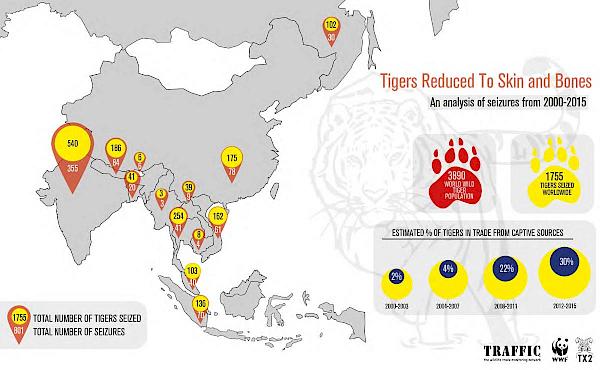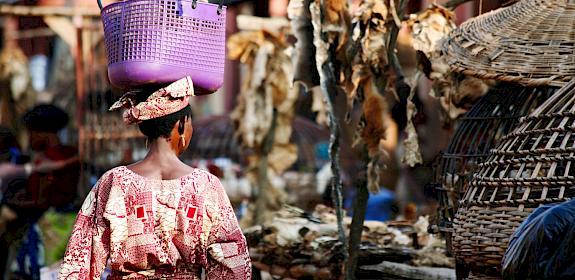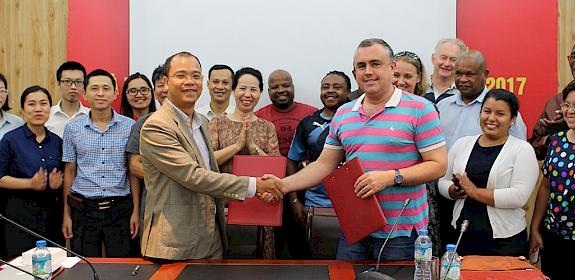
Reduced to skin and bones re-examined: full analysis
An illegal trader holds up Tiger skin © TRAFFIC
i
- »
- Publications »
- Reports »
- Reduced to skin and bones re-examined
Published 16 November 2016
Average of 110 Tigers a year entering the illegal trade chain in Asia over 16 years
Ha Noi, Viet Nam, 16th November 2016 – A comprehensive analysis of 16 years of Tiger seizures shows that Asia’s failure to ramp up enforcement, close Tiger farms, strengthen laws and reduce demand are to blame for the persistent illegal trade in Tiger parts.
Reduced to skin and bones re-examined
Report author(s):
Sarah Stoner, Kanitha Krishnasamy, Talia Wittmann, Steven Delean, Philip Cassey
Publication date:
November 2016
key findings
Reduced To Skin And Bones Re-Examined: Full Analysis, released on the eve of the international conference on illegal wildlife trade taking place this week in Ha Noi, said these issues existed to varying degrees across all the 13 Tiger range countries scrutinized, evidenced by the minimum of 1755 Tigers seized from 2000-2015, an average of more than two animals per week.
With at least 758 whole skins seized, they represent the most common commodity type in trade. Other items seized included bones and Tiger bone wine, claws, canines, paws, gall bladders as well as dead and live Tigers.
Among the findings was the growing proportion of Tiger parts seized suspected to be from captive breeding facilities – from just 2% in the 2000-2003 period to at least 30% in 2012-2015. Such seizures were most pronounced in Lao PDR, Thailand and Viet Nam, where captive breeding facilities were found to be poorly regulated by existing laws.
The rising number of Tigers suspected to be from captive breeding operations is a sure indication that leakage from Tiger farms is occurring and there is no denying the role these facilities play in worsening illegal trade: these countries have clearly made little meaningful progress in controlling this source of supply
Kanitha Krishnasamy, Senior Programme Manager for TRAFFIC in Southeast Asia and a co-author of the latest TRAFFIC report
“The Ha Noi Conference presents an opportunity for governments to take serious action: captive breeding facilities should be phased out and there is an urgent need to overhaul the laws in some countries to prevent commercially bred Tigers from slipping into the illegal trade. Any further stimulation of demand could have a more disastrous impact on wild Tigers.”
The report also found that countries with the best chance of saving wild Tigers continued to grapple with the persistent problem of Tigers being removed from the wild and how to break the chains of supply and demand.
India, the country with the highest population of wild Tigers globally, also recorded the highest number of seizures – a minimum of 540 Tigers seized over 16 years. Indonesia stands out as having made the highest number of seizures in 2015 compared to others – 17 in total. Other Tiger range countries each made between one and eight seizures that year.

“This comprehensive analysis provides important insights for targeting interventions at critical points in the trafficking chain,” said James Compton, TRAFFIC Senior Director for Asia. “Specific recommendations to Tiger Range Countries at national level are complementary to the need for international law enforcement co-operation to disrupt and dismantle criminal activity involving Tigers and tiger parts.”
The authors said the persistently high number of seizures was rooted in the lack of intelligence-led law enforcement efforts that could lead to successful convictions, a problem made worse by weak penalties and lack of successful prosecution of offenders, lack of information sharing and bilateral co-operation.
Efforts to strengthen Tiger conservation efforts and cripple the syndicates bent on emptying the forests of Tigers, especially in their strongholds in India, Russia Nepal, Malaysia and Indonesia, could only be achieved if these problems were addressed.
Demand, too, has not been quelled according to the report, which cites the clamour for taxidermy specimens of Tigers as a luxury item from the Indonesian elite as an example of additional pressure on the declining Sumatran Tiger population.
“Laws in most countries are weak and without fundamental structures in place, the success of any enforcement action is greatly undermined,” said Krishnasamy.
“Wild Tiger range countries must step up their game to beat the odds of extinction.”
at least 1,755
Tigers seized between 2000–2015
758 skins
were seized over the same time period; the most common commodity found in trade
30%
of Tiger products seized are suspected to originate from captive breeding
Related News and Reports
featured in: Asia & Middle East Mammals Trade Monitoring Collaboration & Policy



